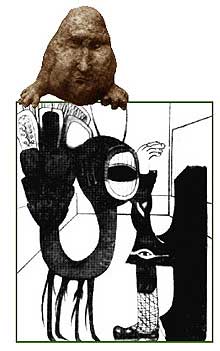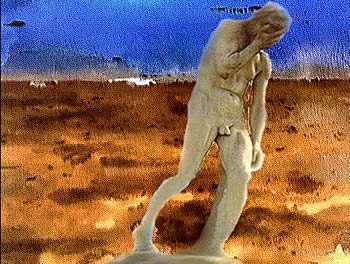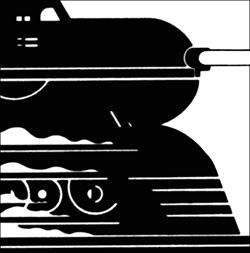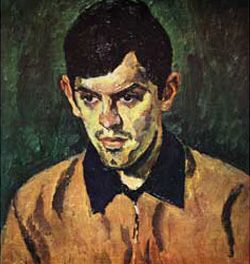But if you are one of those, (the majority I might add), whose knowledge of surrealists extends to an awareness that they endeavor to change lightbulbs in the most unlikely manners, then this could be your big chance.
Be warned, however, you shouldn’t get the impression that figuring it all out will be an easy task. Remember that these surrealists are slippery characters. Just when you think you’ve got a grip on them they squirm out of your grasp and leave you wondering what it’s all about.
Maybe it’s that I’m out of my depth because no matter how hard I try looking into those surrealist paintings in the end all I’m left with is an image of Dali’s mustached smirk. You see, I’ve had my little flirtation with surrealism.
That was many years ago in the South of France…
But that’s a long story. Surrealism has a tale to it too, and Prague had its part to play. The Hapburgs, who seem to have had everything, were not found wanting when it came to the surreal. The artist Giuseppe Arcimboldo worked for them, producing fantastic paintings and drawings.
He could do the most amazing things with fruit and vegetables and the concoctions and countenanced were a mixture of the humorous and the horrific. A far more sinister approach is found in the paintings of Hieronymous Bosch, who in the early 1500’s excelled in works that today would be considered more surreal than the Surrealists, and that at a time when one could suffer the most excruciating physical and mental tortures for dabbling in far gentler arts.
Another predecessor of the modern surrealist is the Englishman William Blake who married poetry and painting in a visionary way. In comparison to Bosch, Blake is mild, but as one who led the flight from the age of reason, he brought to light the inner world of the spirits of emotion of hope and fear.
What could then have been gained was lost in the years that followed when refined Romanticism produced too many self-conscious artists. Surrealism needed a little more volatile mixture than the salons could produce. It required a visionary yet primitive nature with a good dose of something psycho-pathological thrown in.
That experience in the South of France comes to mind. Strolling through Perpignan one day I saw an affiche advertising an exhibition of drawings by Dali. I found the gallery on a quiet side street. The building was so old and petite it would have made a lovely little cake shop. Inside a man was sitting behind a counter near the door. He was busy with paperwork and other office chores, and the rest of the warehouse rooms were empty.
About 40 works were on display and every one was a quick ink drawing of Don Quixote and his accomplices Sancho and Rosanante. As I gazed around me trying to figure out why he didn’t try another image say, James Dean on a motorbike, the thought struck me that it would be so easy to pinch one of those Spanish jockeys.
They were just large sheets of paper pinned to a strip of wood that ran the length of each wall. There were no cameras, no surveillance, it was siesta time or whatever the Academie Francaise call it. It was all so easy. The drawings were all so beautiful even if they were like the Miss World triplets. They were done with such skill. The dark lustre of the black ink on such soft velvety white paper seemed to draw me towards them. They were all signed.
I felt sure I could nick just one. Recalling it now, I realize it was at least the beginning of a surreal experience. It had the right elements you see. The vision, the primitive instinct and that psycho-pathological something.
Later I came to hate art in all its lurid forms. I wallowed in my detest for painting and sculpture and sticking bits of cut out paper together to make pleasing pictures. I loathed the lot. By then of course I was set up for a real psychological trauma. I discovered DADA. There rings a hollow bell. The deeper into DADA I slipped the more I began to realize that the inner reason cannot be anti-art without in the end being arty. But that as I said is another story.
It was, in any case, out of DADAism that surrealism was spawned, which means that it owes its origins to a Swiss Cabaret. The Cabaret Voltaire in Zurich in fact where in 1916 the German Hugo Ball and a host of others attempted to overthrow Art in all its shapes and fashionable forms.
Nearby in a neighborhood cafe Lenin was plotting Social Realism. Soon however Lenin moved to his place in history, and the DADAists moved to Paris and met up with Man Ray, who came all the way from America for the encounter.
The DADAists kept themselves busy in Paris while the world reeled from the shock of the great war, the fear of Czarist Russia, the Collapse of the Hapsburg Empire, the Armistice and the Versailles Peace Conference. But in the end even DADAism could not survive in this new world order and many of its adherents decide to call it a day.
The future for them lay in Surrealism and to be sure that their change of position was duly noted they issued a manifesto, but then in those days it seems everybody was. Surrealism spread, and the new Czechoslovak state with its strong cultural links with Paris was at the front in the early days. It was from the avant-garde Devetsil movement that Czechoslovak Surrealism sprang.
Its earliest promoters were the artist Karel Terge and the poets Konstintin Biebl and Vitaslav Nevzal. In the early 30’s an international surrealist exhibition was held in Prague and the Czech school established its identity and reputation. The exhibition now running in the Prague City Library includes the works of the best known creators of Czech Surrealism.
On a winter’s afternoon I entered the building through a non-descript door on Valentinska and climbed the stairs to the top floor where the gallery is located. Gaining admittance to the exhibition involves you in an out-dated bureaucratic procedure that, though slightly tedious, helps invoke an atmosphere conducive to viewing the show.
In the outer rooms, the corners of which are occupied by either double mirrors or middle-aged women, hang a plethora of paintings, drawings, collages and photographs. Most of the work, as is usual in such large exhibitions of restricted scope, are a bit disappointing, and it is hard to tell if the lack of technique is deliberate or just what it seems to be.
There are a few bright spots, however. Vaclav Tikal’s paintings, particularly his self portrait, combine vivid color and excellent composition and the collages of Libor Fara are worth investigating. Most of the photographs are on the insipid side with a few exceptions. Those of Miroslav Hak are, I think, by far the best, along with those of Vilem Reichmann. Hak’s “In the courtyard” is simple, well done and direct.
It is in the backrooms, as at most parties, where the real action is. These rooms are dominated by the works of the aforementioned Karel Teige and the duo Jindrich Styrsky and Marie Cerminova (Toyen.) These are the cream of the crop. Toyen was an abstract painter who developed a figurative style.
I don’t particularly like her chalky pastel colours and some of her motives look a bit hackneyed. Nor do cracks and fissures convey much these days, but in the 30’s they would have had more meaning. Her “Deserted Den” from 1937 reveals something of her personal life and the times she lived through.
Jindrich Styrsky, whose early paintings also include too many chalky pastels, moved in 1934 to explore the possibilities of collage. He became known for his anti-clerical attitude. His 1941 collage “The Infant Jesus” is an example of his provocative nature. Though, I wonder if it is more a comment on the innocence of Prague under Nazi occupation.
Styrsky’s collages are strong in colour and content; the images are alluring and challenging and are for me the highlight of the show.
The idea that of all the works on display his were the ones I could out on my walls recall to my wandering mind, that hot August afternoon and the temptation to pinch the Dali drawing. It was just inches from my grasp. Maybe I lingered too long in the contemplation of my crime.
I knew I could easily pluck it from the wall, roll it up and slip it inside my shirt. The short stroll to the sidewalk would have been the hardest part, but once outside I could evade the dragnet easily enough. I thought about it, crossing the border to Spain and hiding out in the Figueras.
They would never think of looking for me there. The plans were forming rapidly when the surface of my unconscious mind was disturbed by the presence in the room. I turned and saw the long figure of a man whose face I recognized.
His long black hair, his protruding eyes and the habitual movements of his mouth made a cold shiver run down my spine. It was the renown surrealist. The one that George Bernard Shaw had named Ghoti.
I couldn’t move for a moment. My chance had come and gone. I nodded towards him. His eyes opened even more and his lips parted as if to speak, but all they formed was a silent shape. I left the gallery thinking about the one that got away.





